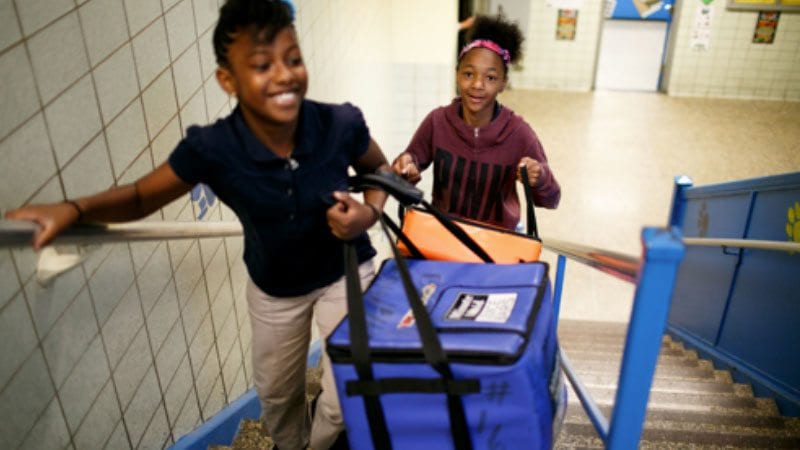Across the country, teachers know how important it is for students to have a full belly to be able to learn. That’s why so many teachers pay for food out of their own pockets. Research shows that the correlation between breakfast and school performance is extremely powerful. Eating breakfast (and especially not eating breakfast) is linked to academics. In addition, countless other research shows how offering breakfast can make a huge impact on attendance and learning. Schools across the country have a sustainable solution, helping kids access the School Breakfast Program.
“A student just can’t learn when hungry,” says Brie Doyle, Ph.D, Senior Manager for National Partnerships for Share Our Strength’s No Kid Hungry campaign, a nonprofit in Washington, D.C. “You have to meet your basic needs before you can even start attending to learning needs.”
With breakfast being a powerful tool, promoting both attendance and test scores, and increasing students’ ability to learn, it’s time to start making it a big priority at schools across America. Nearly one in six children in America lives in households with food insecurity. Schools can be a powerful place to connect kids with available resources. Here are some of the common problems facing classrooms today, along with real solutions to help move the needle.

Problem: My kids come to school hungry and can’t focus on learning.
Solution: Make breakfast part of the school day.
The United States Department of Agriculture administers the National School Breakfast Program, making a nutritious breakfast available to students in most K-12 schools—public, private, and charter—across the country. All students are eligible to participate.
The federal government subsidizes schools’ cost to serve meals through the School Breakfast Program. School nutrition costs remain separated from the general education budget in most districts, so schools participating in the School Breakfast Program must adhere to specific nutritional guidelines in order to claim reimbursement. In 2016, the program served 14.57 million children, but this doesn’t mean all students eat breakfast. Students still face challenges like transportation not arriving early enough to eat breakfast before the school day starts, stigma about eating school meals, lack of awareness of the program or misunderstanding about the nutrition content of meals, or just an overall lack of awareness about the program.
Schools can do their part by making breakfast part of the school day, just like lunch. This way students are nourished and ready to learn. Three “Breakfast After the Bell” models have shown to increase breakfast participation more than the traditional cafeteria-based model and do a better job of meeting students’ needs. These models allow schools to serve breakfast as part of the school day in an easy fashion!
- Breakfast in the Classroom is where breakfast is served and eaten in the classroom after the official start of the school day. Breakfast in the Classroom takes 15 minutes on average. Students often eat while attendance is taken or classroom announcements are made.
- Grab and Go to the Classroom is where students pick up conveniently packaged breakfasts from mobile service carts in high traffic areas, such as hallways, entryways or cafeterias. Students can eat in the classroom before and after the bell has rung.
- Second Chance breakfast is where breakfast is served after first period or during a break between the start of the school day and lunch. Schools often serve Second Chance breakfast using the Grab and Go to the Classroom model or schools re-open the cafeteria and allow students 10-15 minutes to eat.
The United States Department of Agriculture (USDA) does not prescribe any one model, but rather leaves the decision about how to deliver the meals up to officials at the local level, according to John Gallagher, a lead program specialist with school programs for USDA.
If you know of a child who could benefit from breakfast at school, your encouragement can make a big difference. “We find success in nudging students,” Doyle says. Studies show that breakfast participation goes up by as much as 25 percent when an adult in the building encourages students to take advantage of the program. When students fuel up in the morning, research finds that absenteeism, tardiness, school nurse visits and discipline problems go down.
The climate in the classroom changes once kids have eaten, she says. “There is a happy buzz—responsible talking and sharing that sets the tone for the day.”
In some states, there are grants available to cover the start-up costs of school breakfast. For more information see The Partners for Breakfast in the Classroom or check with No Kid Hungry or Action for Healthy Kids in your state for grant opportunities. Teachers can also do their part to work with principals or nutrition staff. Take a look at how this teacher made a difference in her school.

Problem: My students don’t embrace healthy foods.
Solution: School breakfast is healthier than you think.
Thanks to new nutrition standards enacted in 2010 that are backed by science and administered by the United States Department of Agriculture, school meals have less fat, calories, sugar and sodium, and more whole grains, fruits and vegetables. Find out more about the quality of school breakfast with School Breakfast—Healthier Than You Think.
Additionally, USDA has a variety of curriculum materials to educate students about healthy eating through its Team Nutrition initiative. There are downloadable recipes, menu planning tools, and worksheets in English and Spanish.
If your school doesn’t already participate in USDA’s Fresh Fruit and Vegetable Program, encourage your administrators to apply. The program provides funding to introduce elementary school children to a variety of produce options they might not otherwise try, such as kiwi or pineapple.
Finally, consider eating breakfast with your students. If teachers model the behavior of eating healthy school meals, kids will often follow.

Problem: My kids get hungry during after-school programs.
Solution: Take advantage of programs that offer after-school snacks.
Schools that provide after-school activities may be eligible to serve an after-school meal or snack. As a teacher, if you are offering such a program, reach out to your principal and the Food and Nutrition Services Department to let them know you are offering an after-school activity and find out if you can serve a snack. Some eligible activities include homework assistance, tutoring, after-school enrichment classes, and drama and arts programs.
By building bridges with Food and Nutrition Services staff, you can come up with more solutions to provide kids with access to nutritious food, suggests Doyle. “We encourage teachers to learn all they can and become advocates for their kids,” she says.

Problem: In the summer, my kids miss regular school meals.
Solution: Explore ways to support feeding children when school is out.
Many summer meal sites, such as community centers, schools, and churches, serve food with grant money from the federal government. The Summer Food Service Program expects to serve over 175 million free meals to children this summer. Summer meal sites are open to any child age 18 and under and meals are served free of charge.
“Summer can definitely be a scary time to not know where you are going to get your next meal,” Doyle says. “We’ve seen a lot of innovative work with community partners coming together to reach kids for summer meals. If you are working with students over the summer, find out if your site is eligible to serve summer meals. Connect with your school’s Food and Nutrition Services team or other community partners. Staff at the administering state agency can also help connect you to local partners already operating the program who may be interested in expanding. We’ve seen meals delivered to pools, recreation centers, libraries and housing complexes. One of the biggest barriers to serving meals in the summer is figuring out where to find the most kids together. As a teacher providing summer services, you have that information!”
You can also spread the message about summer meals to your students and their families. Encourage them to find the closest summer meal sites and hours of operation by texting ‘FOOD’ or ‘COMIDA’ (for Spanish speakers) to 877-877. Map it online or call 1-866-3HUNGRY to learn more. Along with free food, many sites offer fun learning and recreational activities. Visit No Kid Hungry’s site on Summer Meals for downloadable materials to share.

Problem: On the weekends, my students don’t get enough food.
Solution: Look into backpack programs.
Contact local nonprofits, churches or community centers to see if there is a weekend backpack program available in your area. The Feeding America BackPack program assembles bags of food through 160 local food banks preparing healthy, easy-to-prepare food for about 450,000 children at the end of the week. Use the Food Bank Locator to find a program near your school.
Teachers can take the lead in connecting families with programs and resources, says Diane Whitmore Schanzenbach, an economist at Northwestern University who has researched federal food programs. The solution to providing children with long-term food stability, she suggests, is a multipronged approach that includes accessible school meals, a robust economy so families have enough resources to buy food, a functioning safety net with food stamps, and private charity food pantries.
To learn how you can help and be an advocate for your students and school, get more teacher resources here or contact Brie Doyle, Ph.D, Senior Manager, National Partnerships at No Kid Hungry.
We’d love to know—what hunger issues have you seen in your classroom or school? What solutions have you seen for feeding children at school? Please share in the comments.


